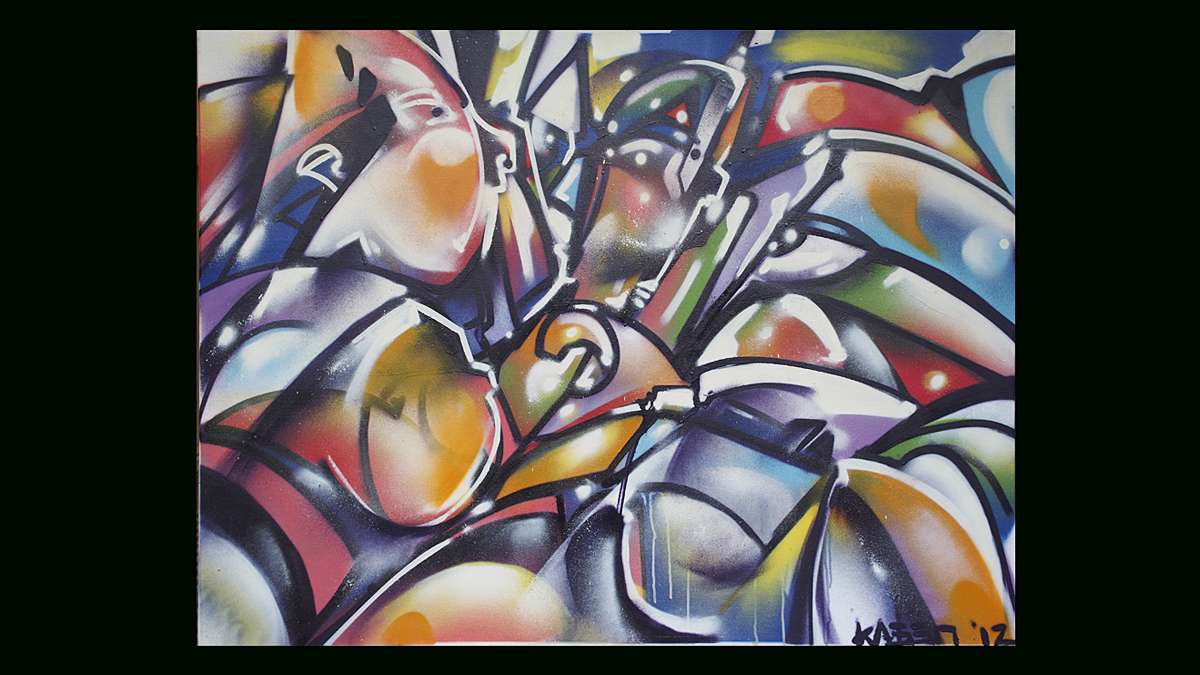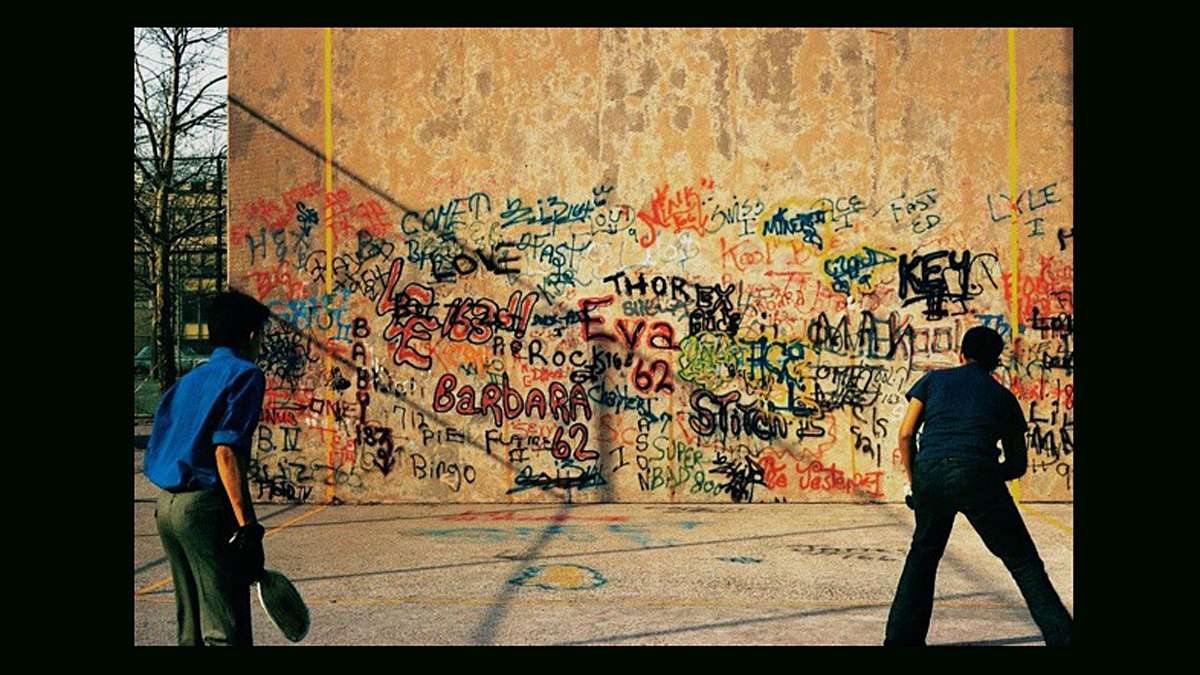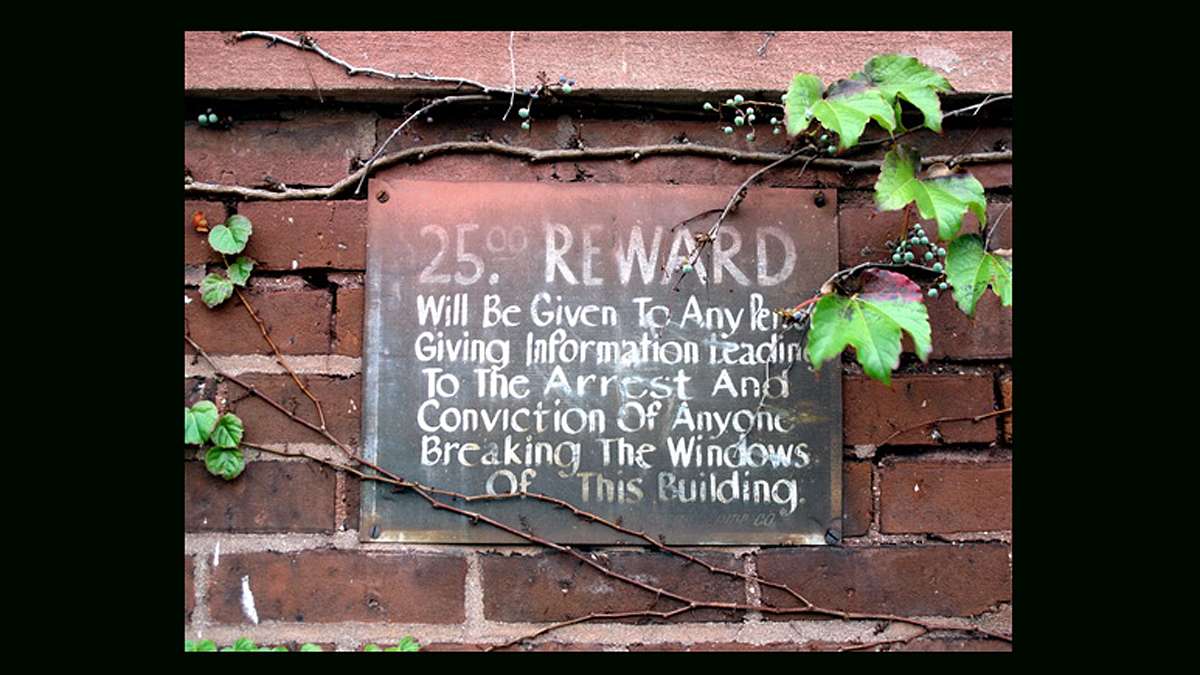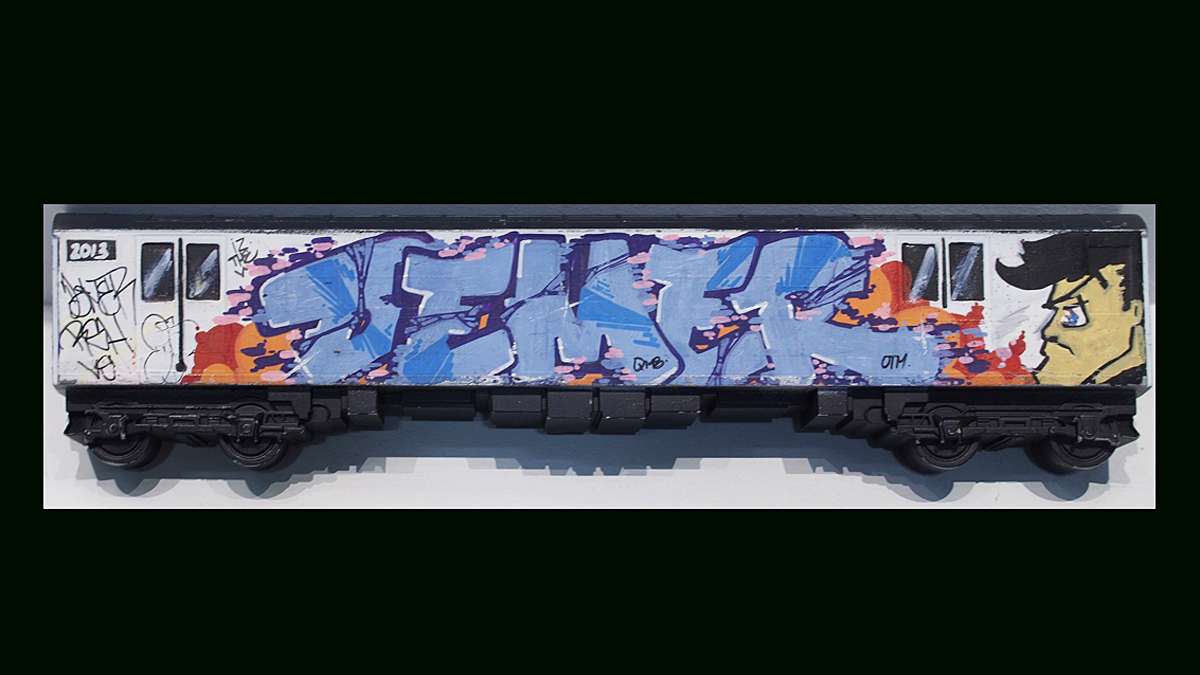Graffiti artists seek to bridge the gap in a hospital setting
The Princeton Photography Club is seeking to engage new communities with its exhibit Subway to Gallery: The Street Artists, on view at Robert Wood Johnson Hospital in Hamilton’s Lakewood Gallery through Nov. 13.
Curator Sheila Geisler, who is president of the photography club, says the show gives viewers the chance to examine this art form up close. “It’s a very different experience than seeing graffiti on a wall as you drive by. A gallery wall allows you the time to absorb all the nuances. Each piece tells a story.”
Geisler worked with noted Trenton street artists Leon Rainbow and Will “KASSO” Condry. The two, who lead a workshop in graffiti writing, also helped establish the SAGE Coalition, the Trenton-based organization that uses art to promote community development. SAGE just completed a mural wall at the Arts Council of Princeton.
Rainbow, who works by day as a web developer for Inforest Communications in Princeton, has been featured on CNN, quoted in the New York Times, and organized mural projects up and down the East Coast. He’s curated numerous exhibits and has been exhibited in museums from Grounds For Sculpture to Ellarslie.
Born in San Jose, Calif., Rainbow – the name derives from his Native American heritage — learned to make block letters from his stepfather. When he was 8 he watched the PBS documentary “Style Wars,” and admired the letters and colors. Using the tag “Xtreme,” he employed markers and spray paint on buses and highways.
Now in his 17th year of recovery from drug addiction, Rainbow, 38, distinguishes between legal and illegal graffiti, and graffiti made on “permission walls” where the property owner has given the OK.
Graffiti has become mainstream — Tylenol, Pepsi, Red Bull and Mountain Dew have used it in ads. “You have to strike a balance between commissions and permissions,” says Rainbow. “With commissions, you are paid for the work, but there is less creative freedom. With permission walls, you barter for your creative freedom. There’s no pay, but you get to do what you want.”
Rainbow, who studied art at Mercer County Community College, believes that to get good, an artist has to practice. “Van Gogh didn’t get good by doing one painting,” he says. “You evolve creatively, and it’s nice to have a little wall where you can play around.”
In his workshops, Rainbow teaches the history of graffiti and how to design letters, draw and sketch. He has students paint on wood panels. Students learn to work communally. “Me and Kasso freestyle a lot. There’s a give and take, we don’t always agree but we work things out. Every wall is different, everything community is different. Kasso does abstraction mixed with portrait, and I do a lot of letter based work and abstraction. We’ll start on our own things and then work them together. Sometimes we work off each other and sometimes we go our own way.”
He compares the process to improv. “It’s like jazz but with paint.”
Rainbow also teaches students that graffiti is not permanent art; it was meant to be painted over.
Whether graffiti is art or vandalism has been debated since humans began making marks, but became formalized in the 1970s when the work of graffiti writer Taki 183 was heralded in The New York Times. By the 1980s, graffiti makers such as Keith Haring and Jean-Michel Basquiat transitioned from the street to fine art galleries and museums.
Before beginning a wall, Rainbow and his crew prime it with house paint. For graffiti his preferred paint is Montana, made specifically for graffiti. It has more pigment and UV resistance than other brands and covers better, with more control for fine details, says Rainbow. Different nozzles fine tune the spray – like different size brushes.
“We want people to understand the difference between vandalism and street art. With this exhibit, we want to show how diverse graffiti is,” says Rainbow. “Here you can see realism, surrealism, pop, abstract and letter art.”
And photography – the exhibit is, after all, put on by the PPC. Among the photographers is Jon Naar, whose 1974 book “The Faith of Graffiti” is considered the bible of the graffiti world. With a forward by Norman Mailer, it is now out of print. “The introduction was like the tail that wagged the dog,” says nonagenarian Naar, who has photographed Andy Warhol, among others. “Mailer compared Cay 161 with Giotto. It was controversial but gave the new art form credibility.”
On one wall is a three-dimensional model of a subway car painted over with graffiti by Demer. Mek does cutout characters. There’s also work by Ras (photorealism), Lank (stencils) and Gentrifried Prufrock (photographs and video). A tag is the name a graffiti writer takes on, versus a “government (pronounced “gov’mint”) name,” the name that appears on an official form of ID.
Another photographer exhibited here, Ricardo Barros, was introduced to the art form in one of Naar’s Saturday morning salons. Barros has been documenting Rainbow’s work on permission walls for his own book of photographs and commentary. He’s followed crews in Rochester, Philadelphia, Camden, Newark, New Brunswick and Trenton.
There’s a photo by Barros of Rainbow working on his installation of “House of Cards” – a sculptural jigsaw puzzle painted over with graffiti – at Ellarslie in 2009. Another photo shows the graffiti class he teaches – from white suburban teenagers to men age 60. Rainbow admits it’s a male-dominated group. “Painting other people’s stuff is somewhat aggressive. It’s dirty, you paint abandoned buildings or on a train line. You go into poor neighborhoods and get bit by ticks and poison ivy. It’s not everyday you go to Art Basel in Miami.”
Art Basel? Has Rainbow been to the pre-eminent art fair? Yes – although he went as a guerilla artist, painting bodies, Porsches and a foundation wall.
It was Barros who connected Rainbow to Geisler and the Princeton Photography Club. Rainbow is sensitive to the healing space the Lakewood Gallery is presenting, and excited by the chance to show graffiti art to those who haven’t seen it before, even if the environment is more conservative than he’s accustomed to. “Our art involves issues of race and class — but art bridges gaps. A gallery exhibit like this starts the dialogue. It’s important that we all work together, and hopefully it will lead to us getting commissions from the hospital. RWJHH is a great member of our community – we’d love to do a large-scale mural for them.”
_________________________________________
The Artful Blogger is written by Ilene Dube and offers a look inside the art world of the greater Princeton area. Ilene Dube is an award-winning arts writer and editor, as well as an artist, curator and activist for the arts.
WHYY is your source for fact-based, in-depth journalism and information. As a nonprofit organization, we rely on financial support from readers like you. Please give today.









